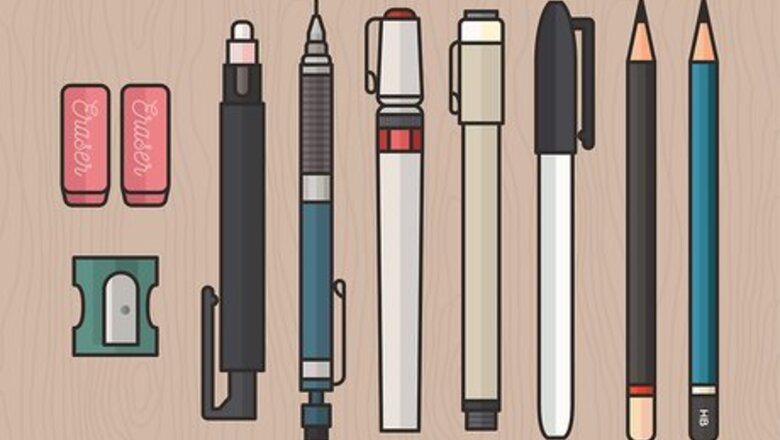
views
X
Research source
But everyone needs to put pen to paper at least occasionally, and good handwriting is not only easier to read, it makes a better impression than illegible “chicken scratch.” Whether you just want to improve your everyday writing, or learn (or re-learn) to write in cursive or calligraphy, there are several simple steps you can take to have more beautiful writing.
Improving Your Basic Penmanship

Choose the right tools. Some people prefer pen, others pencil. Some like them larger, others smaller. The important thing is to find a writing instrument that feels right in your hand. Consider a pen or pencil with a soft grip, especially if you tend to grip too tightly. Use lined paper for practice, and sturdier paper if you are writing something to keep.
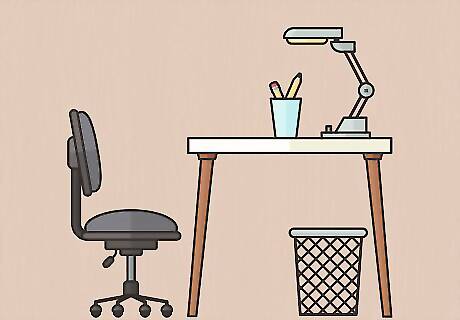
Sit upright but comfortably. Yes, your mother was right -- posture counts. Hunching over your paper will make your neck and back sore after a while, and it also restricts your arm movement so that you will over-utilize your hand and wrist in writing (see Method 2, Step 3 below). If you can sit up straight as a rail and be comfortable, great. But don't make yourself overly rigid and uncomfortable. Beautiful writing should not be a painful chore.
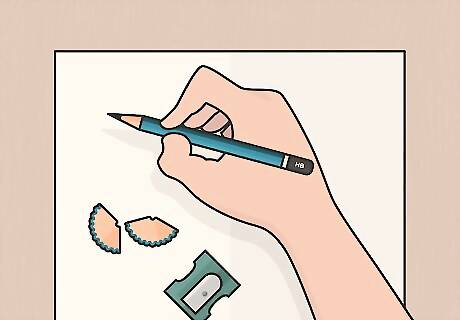
Hold on loosely. Grasp the pen, don't choke it. (They say a good craftsman never blames his tools.) If you have an indentation or red mark on your finger when you finish writing, you're holding on too tight. A looser hold enables a better range of motion and allows the letters to flow more freely from your pen. There are plenty of “right” ways to hold a pen or pencil. Some pin it against the middle finger with the index finger and thumb, some press with the fingertips of all three fingers; some rest the back of the pen on the index finger base knuckle, some on the webbing between index finger and thumb. Instead of spending time forcing yourself to utilize a new grip, go with what is comfortable for you -- unless you find that you use an awkward grip that negatively affects the quality of your writing. So long as you're utilizing your first two fingers and thumb, it should work fine.
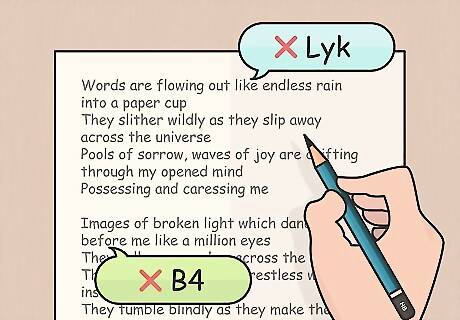
Make your content more beautiful. Sure, it's fine to use abbreviations, symbols, non-sentences, etc. when jotting down notes, but especially when it's something that another person will see, take the time to write properly. A shiny, clean car that's missing two wheels and the hood doesn't look as beautiful as a complete one. Make sure you have the appropriate capitalization and punctuation marks. Don't use text speech or internet abbreviations. If you are writing anything other people are going to read, don't use text writing: Gr8, bcuz, u, soz, lols, etc.
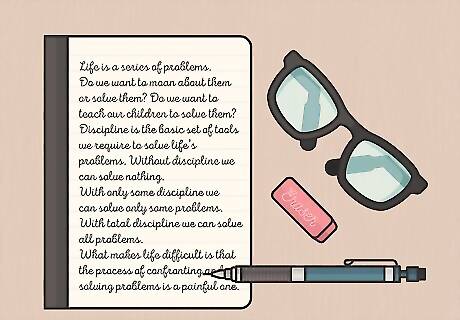
Seek inspiration. Do you know someone with beautiful handwriting? Watch him or her write and ask for some pointers. You may even want to look at word processor fonts for inspiration on letter shapes. Don't be too proud to seek out writing lessons and workbooks marketed for schoolchildren. For that matter, if you have children, practice together. Turn family bonding time into better penmanship for all.
Writing More Beautiful Cursive
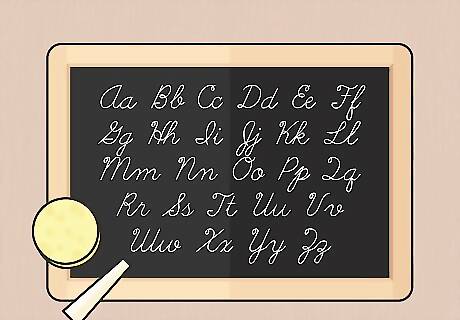
Study the cursive alphabet. Odds are you've forgotten what some of the cursive letters look like since grade school. Seek out some of the many cursive practice books that have lines on the paper to help you practice making the cursive letters. There is more than one style of cursive, of course, and it is fine to give your cursive an individual flare, as long as it is still legible. But it's probably best to start out by copying an existing style. Seek out websites with study tutorials and printable practice sheets. Some even have animations of the pen strokes used to make each letter.
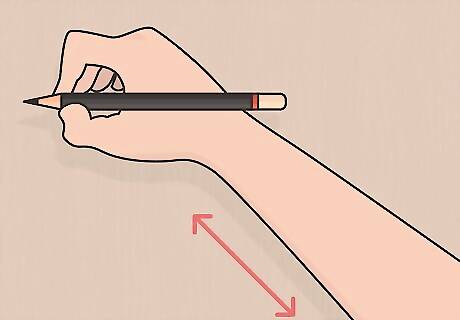
Practice using your whole arm to write. Most people write by manipulating their fingers, what is called by some “drawing” the letters. Handwriting artists utilize their arms and shoulders as they write, which facilitates a better flow and thus less angular, choppy handwriting. Try “air writing.” You may feel silly doing it, but it will help re-train your muscles. Pretend you are writing large letters on a chalkboard. (In fact, you can practice writing on a chalkboard.) You will naturally use shoulder rotation and forearm movement to construct your letters. As you become more proficient at air writing, reduce the size of your invisible letters and assume the positioning you would take to put pen to paper. But continue to focus on using your shoulder and arm, not your fingers.
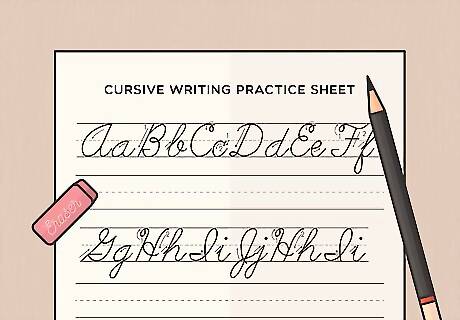
Practice basic cursive pen strokes. The two essential moves in cursive handwriting are the upsweep and the curve, so practice them first before writing full letters. You'll want your practice stokes and eventually your letters to be evenly spaced, so lined paper will be really useful here. If you want to write on a blank piece of paper, put in light, evenly spaced pencil lines with a ruler and erase the lines once you've written your letters. To practice the upsweep, start the pen just above the baseline, brush against the baseline as you pull down and slightly forward, then turn the curve upward into a straight line (angled slightly forward) through the midline and to the topline. The basic curve practice stroke resembles a lowercase “c.” Start just below the midline, pull up and back to make nearly a complete counterclockwise, forward-leaning oval (taller than wide), brushing against the midline and baseline as you go and stopping about three-fourths of the way up to your starting point. As you move on to practicing whole letters and combinations, don't forget about the connections. In cursive, they are the “air,” the space between pen strokes when the pen is lifted in script writing. Proper connections will make your cursive writing not only more beautiful, but faster.

Start slow. Cursive writing is about writing faster by reducing pen lifts, but start out by practicing forming each letter and connection deliberately and precisely. Pick up the pace only as you master the form. Think of cursive writing as an art, because it is one.
Learning Basic Calligraphy

Get the right tools. To get the attractive appearance of your calligraphy strokes appearing thick and thin, you'll need to make sure that you have the proper pens, paper and ink. The best writing utensils for calligraphy are broad-edged ones like markers, fountain pens, brushes, quills, reeds, or staff with inserted tips (called nibs). Make sure that you have paper that ink won't bleed through. Practicing on plain, standard notebook paper is fine, but you'll need to test that the ink won't bleed through. Most stationery stores sell paper that is made for calligraphy. If you're going to use inks, avoid India drawing inks because the lacquer in them has a tendency to clog the pen and rust the nib. You're better off using a water soluble ink.

Set up your paper properly. This means understanding where the lines go so that your calligraphy has uniformity of appearance. You definitely want to choose lined paper for practice. Either use pre-lined paper, place paper with dark lines under your practice sheet, or use a pencil and ruler to draw parallel lines on your practice sheet. You'll need to set a nib height -- that is, the space between guide lines as measured by the width of your pen nib. (The width of the widest part of your pen tip equals 1 “nib” in this equation). A common standard is 5 nibs between guidelines. The guidelines include the baseline, the waistline, and the ascending and descending lines. The baseline is the writing line that all letters rest on. The waistline is the line above the baseline, which changes according to the x-height of the letter (in this case, 5 nibs above baseline). The ascending line marks the height that all ascending letters (such as a lowercase “h” or “l”) hit. It will be 5 nibs above the waistline (or whichever nib height you're using). The descending line is where descending letters (such as lowercase “g” or “p”) hit below the baseline. It will be in this example 5 nibs below the baseline.

Position yourself and your pen. As advised to improve any style of writing, sit with your feet on the floor and your back straight (but not uncomfortably rigid). Likewise, hold the pen so that it is under control but not in a vise grip, or your hand may cramp. Calligraphy requires you to hold your pen nib at a 45 degree angle. To make sure that you're holding your pen at a 45 degree angle, draw a right angle (90 degrees) with a pencil. Draw a line upward from the corner of the angle that cuts the right angle in half. If it's a thin line, then you're holding your pen properly.

Practice primary strokes. In calligraphy, these include the vertical downstroke, push/pull strokes, and branching strokes. For the vertical downstroke, practice drawing thick, straight lines down from the ascending line to the baseline and the waistline to the baseline. Slightly lean the line forward after some practice. Eventually you will add “tails” (short thin-line strokes) to the beginning and end of your downstrokes, but save that for later practice. For push-pull strokes, make short, thick horizontal lines along the waistline. This stroke will make the tops of a lowercase “a,” “g”, the cross of a “t,” and others. You may eventually add a slight wave and/or tails to this stroke, but stick to a straight line at first. For branching strokes, make a curved line, slightly leaned forward, from the baseline to the ascending line and waistline to baseline. You will use this motion to make lowercase “n” and “v,” for example. Practice starting the line thick and ending thin and vice versa -- you will need to be able to do both. As you improve with these motions, make shapes like boxes, triangles, and ovals before moving on to the actual letter forms. Pay special attention to keeping the 45 degree angle.
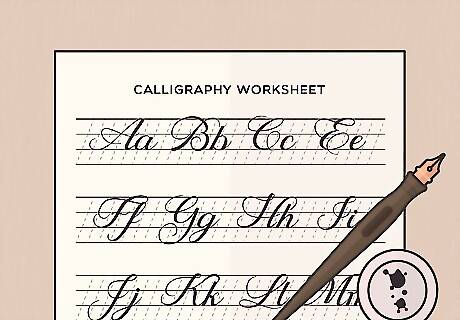
Take your time. Unlike cursive, in calligraphy each letter requires one or more pen lifts. As you move into practicing letters, focus on each stroke used to make a letter. Get each piece of the puzzle in place, then assemble that letter.

Consider taking a class. If you are serious about learning calligraphy, you may want to consider seeking out a calligraphy class at an art school or perhaps even a community center. Calligraphy is truly an art form, and proper, guided instruction can prove very helpful to many aspiring calligraphers. But even self-taught calligraphy can be beautiful and improve your writing form in general.














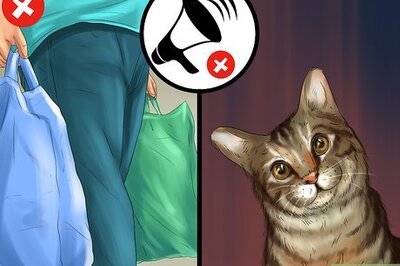




Comments
0 comment